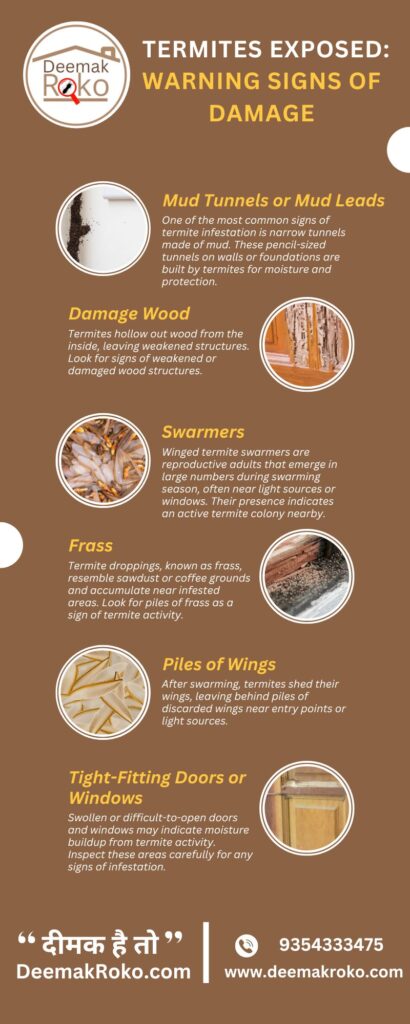Termite Damage: Recognizing Signs and Understanding Termites!
Understanding termites is essential in safeguarding your home from termite damage. By spotting early signs of infestation, homeowners can take preventive measures to protect their property. Termites, known as silent destroyers, can cause significant harm if left undetected. This guide provides insights into termite behavior and how to recognize signs of damage, empowering homeowners to take proactive steps in termite prevention.

Introduction to Termites
What are Termites?
- Termites, as social insects, are known for their wood-eating habits.
- Additionally, they are classified into three main groups: dampwood, drywood, and subterranean termites.
- Moreover, the lifecycle of termites includes egg, nymph, and adult stages.
Role of Termites in Ecosystems
- Termites play a crucial role in ecosystem health aiding in decomposition.
- They contribute to soil fertility through their tunneling activities.
- Termites interact with other organisms like ants and fungi in complex ways.
Common Species of Termites
- Worldwide, there are over 2,700 species of termites.
- Furthermore, different termite species have unique distributions and characteristics.
- Additionally, major species include the subterranean termite, drywood termite, and Formosan termite.
Understanding Termite Behavior
Feeding Habits of Termites
- Termites feed on cellulose found in wood, plants, and paper.
- Moreover, they locate food sources through pheromone trails and vibrations.
- This feeding behavior can lead to extensive damage in infested structures.
Nesting Patterns of Termites
- Termite nests can be found underground, inside wood, or above ground.
- Additionally, nests are complex structures with chambers for various functions.
- Furthermore, factors like temperature and humidity influence nesting behavior.
Communication Among Termites
- Termites communicate through chemical signals and vibrations.
- Communication is vital for coordinating tasks within termite colonies.
- Pheromones play a key role in signaling danger or food sources.
Signs of Termite Damage
- Hollow-sounding Wood: When tapping wooden surfaces, listen for a hollow sound, indicating internal wood consumption by termites.
- Sagging Floors and Ceilings: As termites devour wooden support structures, floors and ceilings may start to sag or warp over time.
- Mud Tubes: Subterranean termites construct mud tubes along surfaces, serving as protective pathways between their nests and food sources.
- Discarded Wings: After swarming, reproductive termites discard their wings, leaving piles near entry points like windowsills and doors.
- Frass: Resembling sawdust or pellets, termite droppings, or frass, accumulate near infested areas, signaling ongoing activity.
- Cracked or Bubbling Paint: Termites tunnel beneath surfaces, causing paint to crack or bubble, a telltale sign of hidden infestation.
- Tight-Fitting Doors and Windows: Swollen wooden frames suggest moisture buildup from termite activity, impacting the functionality of doors and windows.
Precautionary Measures for Termite Prevention
- Maintain proper ventilation and address moisture issues in buildings.
- Regularly inspect wooden structures for signs of termite activity.
- Install physical barriers like metal screens to deter termites.
Natural Remedies for Termite Control
- Beneficial nematodes are natural predators of termites.
- Boric acid can be used as a DIY treatment against termites.
- Neem oil solutions can disrupt termite growth and reproduction.
Professional Termite Treatment Options
- Chemical treatments are commonly used for severe termite infestations.
- Baiting systems attract termites to poisoned baits, controlling populations.
- Fumigation techniques involve sealing a building and releasing fumigants to eradicate termites.
Summary and FAQs
Recap of Key Points
- Understanding termite behavior is essential for effective pest control.
- Identifying signs of termite damage early can prevent costly repairs.
- Taking proactive measures and seeking professional help can safeguard properties from termites.
Frequently Asked Questions about Termites
1. How do termites differ from ants?
- Appearance: Termites have a thick waist and straight antennae, while ants have a narrow waist and elbowed antennae.
- Diet and Nesting: Termites primarily feed on wood cellulose and nest underground or within wooden structures, while ants have a varied diet and nest in soil, wood, or mounds.
- Social Structure: Termite colonies show less caste differentiation, whereas ant colonies have distinct castes with specialized roles.
2. Can termites cause structural damage to buildings?
- Extent of Damage: Indeed, termites can cause significant structural damage to buildings by feeding on wood, thereby compromising its strength and integrity over time.
- Silent Invaders: Moreover, termites often go unnoticed as they tunnel through wooden structures, causing damage from the inside out without obvious signs until the infestation is severe.
- Costly Consequences: Consequently, if left untreated, termite infestations can lead to expensive repairs and structural instability, ultimately posing a threat to the safety and value of the building.
3. What should I do if I suspect a termite infestation in my home?
- Assess the Situation: Firstly, carefully inspect your property for signs of termite activity, such as mud tubes, hollow-sounding wood, or discarded wings. Take note of any areas showing damage or unusual signs.
- Seek Professional Assistance: Next, contact a reputable pest control company specializing in termite inspections and treatments. Professional exterminators can accurately assess the extent of the infestation and recommend appropriate treatment options.
- Take Preventive Measures: While awaiting professional help, take proactive steps to minimize further damage. Avoid disturbing potential termite nests or infested areas, and consider implementing preventive measures like reducing moisture sources and eliminating wood-to-soil contact around your home.
In conclusion, understanding the behavior of termites and being able to identify signs of termite damage are crucial for effective pest control and prevention. By taking proactive steps and seeking professional assistance when needed, homeowners can protect their properties from the destructive effects of termites
